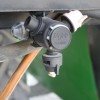 Calibration is the process used to determine the amount of chemical material applied per unit area. Equipment for applying liquid and dry materials must be accurately calibrated for pesticides to work efficiently and to avoid crop injury or death. The pesticide label is a legal document and must be followed. Properly calibrating equipment ensures the product is being applied as specified on the label and that environmental contamination will be minimized. This 6-page fact sheet discusses some methods for calibration of sprayers and dry material spreaders and includes information about calibration to help growers properly apply pesticides. written by M. R. Miller and P. J. Dittmar, and published by the UF Department of Horticultural Sciences, May 2013.
Calibration is the process used to determine the amount of chemical material applied per unit area. Equipment for applying liquid and dry materials must be accurately calibrated for pesticides to work efficiently and to avoid crop injury or death. The pesticide label is a legal document and must be followed. Properly calibrating equipment ensures the product is being applied as specified on the label and that environmental contamination will be minimized. This 6-page fact sheet discusses some methods for calibration of sprayers and dry material spreaders and includes information about calibration to help growers properly apply pesticides. written by M. R. Miller and P. J. Dittmar, and published by the UF Department of Horticultural Sciences, May 2013.
http://edis.ifas.ufl.edu/hs1220
Tag: Herbicide Calibration and Application
Calibrating Equipment for Aquatic Herbicide Application (PI236)

Calibration is the process of measuring and adjusting equipment performance. It is not difficult, but it does require some math. This 12-page fact sheet provides standard formulas and conversion factors incorporated into practical examples to help with calibration. Written by F.M. Fishel and published by the UF Department of Agronomy, July 2011.
http://edis.ifas.ufl.edu/pi236
SSAGR102/WG013 Calibration of Herbicide Applicators
Revised! SS-AGR-102, a 3-page illustrated fact sheet by J.A. Ferrell and B.A. Sellers, describes two common methods for sprayer calibration, the 5940 method and the 1/128th acre method. Published by the UF Department of Agronomy, October 2009.
http://edis.ifas.ufl.edu/WG013